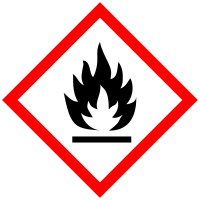
Improving Member States preparedness to face an HNS pollution of the Marine System (HNS-MS)
N-Butyl Acrylate
Description Top
| CAS number | 141-32-2 |
| UN number | 2348 |
| Chemical formula | C7H12O2 |
| Accident occurred | Yes |
| Standard European Behaviour Classification (SEBC) | Floater that evaporates and dissolves (FED) |
| Notable risks | Polymerize easily, inhibitor in comercial products. |
GESAMP Hazard profile
| A1 | A2 | B1 | B2 | C1 | C2 | C3 | D1 | D2 | D3 | E1 | E2 | E3 |
| 2 | R | 3 | NI | 1 | 1 | 1 | 2 | 2 | SsA | NI | FED | 2 |
Marine pollution Classification (MARPOL Annex II)
| Category | Description |
| Y | Noxious Liquid Substances which, if discharged into the sea from tank cleaning or deballasting operations, are deemed to present a hazard to either marine resources or human health or cause harm to amenities or other legitimate uses of the sea and therefore justify a limitation on the quality and quantity of the discharge into the marine environment. |
Alternate names for this chemical
Acrylic Acid, Butyl Ester
Acrylic Acid, N-Butyl Ester
Butyl 2-Propenoate
2-Propenoic Acid, Butyl Ester
2-Propenoic Acid, N-Butyl Ester
Acrylate De N-Butyle
Butyl Acrylate
N-Butyl Acrylate
Acrylate De Butyle
Acrylic Acid, N-Butyl Ester
Butyl 2-Propenoate
2-Propenoic Acid, Butyl Ester
2-Propenoic Acid, N-Butyl Ester
Acrylate De N-Butyle
Butyl Acrylate
N-Butyl Acrylate
Acrylate De Butyle
Physico-chemical properties Top
| Chemical formula | C7H12O2 | ||||
| Molar mass | 128.17 [g/mol] | ||||
| State | Liquid at 25°C and 1 atm | ||||
| Fusion temperature | -64.6 [°C] | ||||
| Boiling temperature | 148.8 [°C] | ||||
| Density |
|
||||
| Surface tension |
|
||||
| Interfacial tension |
|
||||
| Kinematic viscosity |
|
||||
| Hydrosolubility |
|
||||
| Vapour pressure |
|
||||
| Vapour density | 3.9 | ||||
| Flash point (Pensky-Martens closed cup) | 39 [°C] | ||||
| Flash point (Cleveland open cup) | 47.8 [°C] | ||||
| Lower explosivity limit (LEL) | 1.3 [%] | ||||
| Upper explosivity limit (UEL) | 9.9 [%] | ||||
| Combustion enthalpy | 29400000 [J/Kg] | ||||
| Specific heat capacity | 1958 [J/(Kg·K)] | ||||
| Combustion efficiency | 96 [%] | ||||
| Mass flow rate of the combustion surface | 0.05 [Kg/(m²·s)] | ||||
| Radiative fraction | 23 [%] | ||||
| Henry's constant | 46.59 [mol/(m³·Pa)] |
Behaviour Top
| Log Kow | 2.36 |
| Log Koc | 1.54 |
| Hydrolysis (Half-life) | 1100 days |
| Aqueous photolysis (Half-life) | 0.0138 day |
| Biodegradation in estuary environment (Half-life) | 10 days |
| Biodegradation in marine environment (Half-life) | 10 days |
| Standard European Behaviour Classification (SEBC) | Floater that evaporates and dissolves (FED) |
| Bioconcentration factor (BCF) | 13.1 |
Ecotoxicity Top
| Lowest median lethal concentration (LC50) on algae | 2.6 [mg/l] | ||
| Lowest median lethal concentration (LC50) on crustacean | 8.2 [mg/l] | ||
| Lowest median lethal concentration (LC50) on fishes | 2.1 [mg/l] | ||
| Highest no observed effect concentration (NOEC) on crustacean | 0.136 [mg/l] | ||
| Assessment factor (AF) |
|
||
| Predicted No Effect Concentration (PNEC) |
|
Hazards Top


Warning
Hazards statements
Health
H315
Causes skin irritation.
H317
May cause an allergic skin reaction.
H319
Causes serious eye irritation.
H332
Harmful if inhaled.
H335
May cause respiratory irritation.
Environmental
H412
Harmful to aquatic life with long lasting effects.
Precautionary statements
Prevention
P261
Avoid breathing dust/fume/gas/mist/vapours/spray.
P273
Avoid release to the environment.
P280
Wear protective gloves/protective clothing/eye protection/face protection.
Response
P305 + P351 + P338
IF IN EYES: Rinse cautiously with water for several minutes. Remove contact lenses, if present and easy to do. Continue rinsing.
GESAMP Top
GESAMP Hazard profile
| A1 | A2 | B1 | B2 | C1 | C2 | C3 | D1 | D2 | D3 | E1 | E2 | E3 |
| 2 | R | 3 | NI | 1 | 1 | 1 | 2 | 2 | SsA | NI | FED | 2 |
A1: Bioaccumulation
| Rating | Description |
| 2 | Low potential to bioaccumulate |
A1a:
| Rating | Description | Criteria [mg/l] |
| 2 | Low potential to bioaccumulate | 2 ≤ Log Kow < 3 |
A1b:
| Rating | Description |
| NI | No Information |
A2: Biodegradation
| Rating | Description |
| R | Readily biodegradable |
B1: Acute aquatic toxicity
| Rating | Description | Criteria [mg/l] |
| 3 | Moderately toxic | 1 < LC/EC/IC50 ≤ 10 |
B2: Chronic aquatic toxicity
| Rating | Description |
| NI | No Information |
C1: Acute oral toxicity
| Rating | Description | Criteria [mg/Kg] |
| 1 | Slight | 300 < AOTE ≤ 2000 |
C2: Acute dermal toxicity (skin contact)
| Rating | Description | Criteria [mg/Kg] |
| 1 | Slight | 1000 < ADTE ≤ 2000 |
C3: Acute inhalation toxicity
| Rating | Description | Criteria [mg/l] (4 hours exposure) |
| 1 | Slight | 10 < AITE ≤ 20 |
D1: Skin irritation or corrosion
| Rating | Description | Sign | GHS category |
| 2 | Irritating | Marked erythema, Obvio | Irritant Category 2 |
D2: Eye irritation
| Rating | Description | Sign | GHS category |
| 2 | Irritating | Marked conjunctival hy | Irritant Category 2A |
D3: Long-term health effects
| Notation | Hazard endpoint | Description | GHS category |
| Ss | Skin Sensitization | Cause specific skin hypersensitivity or allergy following skin contact | Category 1 for Skin Sensitizers |
| A | Aspiration | Lung injury or chemical pneumonia following aspiration of a chemical through the oral or nasal cavity into the trachea or lower respiratory system | Category 1 for Aspiration Toxicity |
E1: Tainting of seafood
| Rating | Description |
| NI | No Information |
E2: Behaviour of chemicals in the marine environment
| Rating | Description |
| FED | Floater that evaporates and dissolves |
E3: Interference with the use of coastal amenities
| Rating | Interference | Description | Interpretation | Warning |
| 2 | Moderately objectionable | 1 is a persistent floater; and/or 2 is moderately acutely toxic; and/or 3 is irritating to skin and/or eyes; and/or 4 has long-term health effects other than carcinogenicity, mutagenicity or reprotoxicity; and/or 5 is highly flammable; and/or 6 is moderately flammable and is a floater with evaporative properties | 1 E2 = Fp; and/or 2 C1 and/or C2 and/or C3 = 23; and/or 3 D1 and/or D2 = 2; and/or 4 D3 contains Ss, Sr, T, A, N, or I; and/or 5 Flashpoint <23°C; and/or 6 Flashpoint 23°C to 60°C and E2 = FE or FED | Warning issued and possible closure of amenities |
GHS Security Information


Warning
About the project
HNS-MS is a decision-support tool that Belgian and French maritime authorities as well as coastguard stations can activate in order to forecast the drift, fate and behavior of acute marine pollution by Harmful Noxious Substances (HNS) accidentally released in the marine system.
Contact us
Copyright © 2015–2026 HNS-MS Consortium
 HNS-MS has been funded by DG-ECHO under agreement ECHO/SUB/2014/693705 and runs from 1 January 2015 to 31 March 2017.
HNS-MS has been funded by DG-ECHO under agreement ECHO/SUB/2014/693705 and runs from 1 January 2015 to 31 March 2017.